
Sensata Technologies – Gigavac
GIGAVAC, a leading manufacturer of contactors, offers a wide range of high-quality products for various applications. With their state-of-the-art facility located in Carpinteria, California, GIGAVAC designs and engineers all their high power relays and power contactors.
In addition to their standard products, GIGAVAC also specializes in compact high voltage relays and high voltage reed relays, specifically tailored for specialized DC and RF applications. This diverse product line ensures that customers can find the right relay or contactor to meet their specific needs.
GIGAVAC takes pride in their highly experienced engineering team, who are capable of providing special modifications to their products, ensuring they are perfectly suited for your unique application requirements. Whether you require a customized solution or a standard product, GIGAVAC has the expertise to deliver.
As a customer, you can rely on GIGAVAC's commitment to excellent service. They invest in maintaining a large inventory, allowing them to provide most products directly from stock or with very short lead times. This means you can count on quick delivery and reduced downtime for your projects.
To conveniently access GIGAVAC's advanced switching solutions, you have the option to purchase their high voltage relays, DC contactors, and other products directly from them. Whether you need a single piece or thousands, GIGAVAC is your reliable source for high-quality switching solutions.
Choose GIGAVAC as your trusted partner when it comes to contactors and relays, and experience their commitment to innovation, quality, and customer satisfaction.
Proximity Sensors
Results:
Results remaining:0
Applied Filters:
Sensata Technologies – Gigavac
No data |
About Proximity Sensors
Proximity sensors are devices that are designed to detect the presence or absence of objects within a specified range. These sensors are essential in industrial and manufacturing settings, where they are used to monitor movement and ensure safety.
The range of proximity sensors can vary from 0 inches (0 mm) up to 50 feet (15.2 m). The sensors utilize different detection principles, including capacitive, inductive, infrared, light, and ultrasonic. Capacitive sensors detect changes in capacitance caused by the presence of an object, while inductive sensors use electromagnetic fields to detect metallic objects. Infrared sensors utilize infrared light to detect objects, while light sensors rely on visible light. Ultrasonic sensors emit high-frequency sound waves and detect reflections from nearby objects.
The output types of proximity sensors also vary depending on their specific applications. Analog current or voltage outputs are used for continuous measurement, while configurable outputs can be adjusted to specific settings. I2C outputs enable digital communication, while NC and NO outputs indicate whether the sensor is normally closed or normally open. NPN and PNP outputs are used to indicate the type of transistor used in the sensor, and push-pull and relay outputs are used to control external devices. Some sensors require an amplifier or SCR for signal conditioning or amplification.
Proximity sensors are used in a variety of applications, including automated manufacturing and assembly lines, security systems, and robotics. They can also be used in consumer electronics, such as smartphones and tablets, to detect movement and adjust device settings accordingly.
In summary, proximity sensors are crucial devices used to detect and respond to movement within a specified range. They utilize different detection principles and offer various output types to cater to specific application requirements. These sensors are used in industrial and manufacturing settings, as well as consumer electronics, to monitor movement and ensure safety and efficiency.
